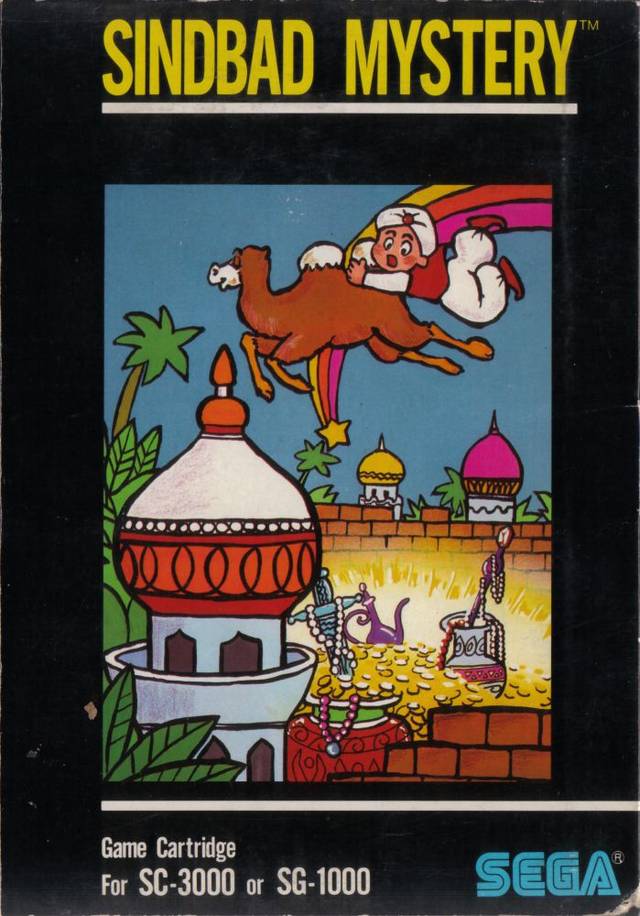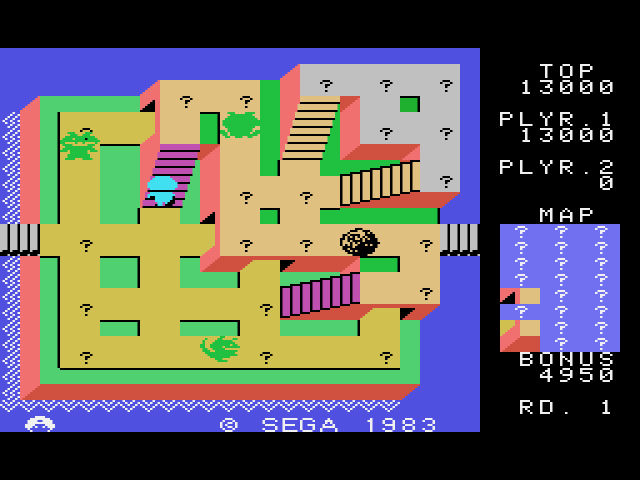
PLAYERS: 1-2 alternating
PUBLISHER/DEVELOPER: Sega
GENRE: Arcade
RELEASE DATE: 1983 (JP)
Sindbad Mystery is yet another forgettable Sega arcade port, a pseudo-isometric Pac-Man clone with poor handling and curious Arabic spelling of the name ‘Sinbad.’ You control Sindbad the Sailor – he of the famous Middle-Eastern adventure stories – across three square-shaped, multi-colored mazes in search of treasure.
The mazes contain stairs to higher platforms, hidden passageways, monsters, boulders which you roll to squish said monsters, and most importantly, question marks. Avoid the monsters, collect the question marks to uncover the map on the side of the screen, and reveal the treasure somewhere in the maze.
Sounds simple, but Sindbad controls like he has eons of sand stored up in his poofy pants. He would often get stuck on corners or just not respond at all to my input. The SG-1000’s built-in SJ-200 controller is known for its faulty joystick, but I was using the D-Pad on my Wii Classic Controller and Sindbad still couldn’t turn effectively.
At any rate, once the treasure’s been uncovered, a skull appears a la Adventures of Lolo-style and chases Sindbad. Gather the treasure and move on to the next maze. After the third unique maze, Sindbad Mystery repeats back to the first level with more aggressive monsters and… that’s it. The additional monster blood lust combined with the terrible controls ensures that you won’t get far past the fourth level, but if your opinion of Sindbad Mystery is anything like mine, you won’t really care.

Are Sega’s early 80s arcade games as mediocre as they seem? N-Sub, Safari Hunting, Congo Bongo, Champion Baseball, and Sindbad Mystery are all pretty games with shallow objectives, and consequently, limited replay value. Since the SG-1000 ports strip the graphical beauty (and in the case of Congo Bongo, two entire levels) from their arcade counterparts, said shallowness becomes even more apparent. At least Star Jacker, Yamato, and Borderline compel the player to reach for a higher score. It doesn’t matter if the latter SG-1000 ports are uglier than the arcade since the gameplay is more addictive. Still, one would think that a company like Sega – a company that prided itself on its arcade output – would have created more consistently interesting titles.

Granted, I am only twelve games into the SG-1000’s library. Perhaps Sega’s later arcade ports will be fresher and more engaging. Besides, 1983 was a bad time for the arcade industry at large, not just Sega. Supporting a system single-handedly (as they more or less did with the SG-1000) while continuing to create arcade titles would be a challenge for any company.
For the meantime, I’ll give Sega the benefit of the doubt. I didn’t start this blog to badmouth them. Heck, I want to appreciate Sega’s games. I’m not excited about trudging through another derivative, poorly-developed slog like Sindbad Mystery or any of the other handful of games I mentioned, but if I’m going to achieve a thorough knowledge of Sega’s console output, trudge I must.
D+


2 replies on “Sindbad Mystery (SG-1000, 1983)”
I’ll be honest with you, I’ve always considered myself a Sega guy, but I didn’t really start until the Genesis. Around 10 years ago I got on this emulator kick and started downloading all of these old Sega arcade games, and I have to admit, Sega’s early games are mostly pretty bad. There are some diamonds in the rough, but I found them to be mostly crappy knock-offs of better games. Fortunately, there is a light at the end of the tunnel. I promise once you get past this SG-1000 junk, things do suddenly get much better.
Actually, you can spell it Sindbad. But I guess knowing that wouldn’t make the game more enjoyable.